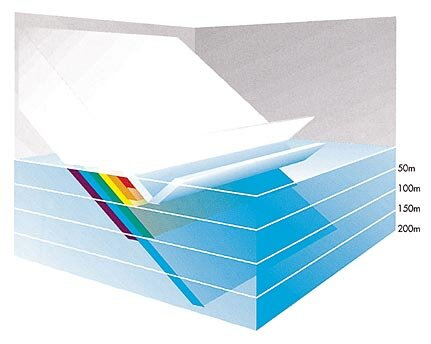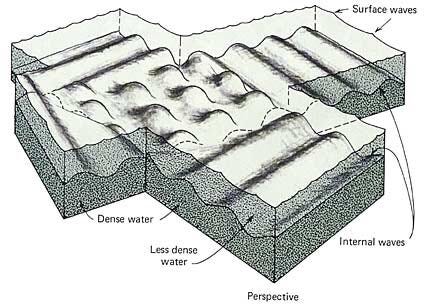Studies related to marine sciences and sea depths did not practically start before the beginning of the eighteenth century, when appropriate instruments and techniques were available and when advanced submarines were invented.
After many decades of research the following facts were established:
The sea divides into two major parts:
The surface sea that is penetrated by the solar energy and light.
The deep sea where the solar energy and light are non-existent.
The deep sea and surface sea differ in temperature, density, pressure, the amount of sun light and the creatures living in each of them. They are separated by internal waves.
Sea internal waves - internal waves cover the deep sea and serve as a boundary between the deep sea and the surface sea. Surface waves cover the sea surface and serve as a boundary between water and air. Internal waves were discovered in 1904. The lengths of internal waves range from tens to hundreds of kilometers. Their height ranges from 10 meters and 100 meters.
The deeper the sea the darker it becomes till it gets as dark as pitch from the depth of about (200) meters. At this depth there starts the thermocline that separates the warm surface waters from the cold waters of the deep. In it we find the internal waves that cover the cold water in the depth of the sea. Light disappears completely at the depth of 100 meters. In deep seas there are several layers of darkness, and light is non-existent in them. Living organisms and fish that live in them depend on chemical energy to produce light with which to find their way. Some species are blind and use means other than sight to sense their surroundings. Darkness begins at the depth of about 200 meters, and the entire visible light disappears at the depth of about 1000 meters. The structure of these fish is mostly water to withstand the enormous pressure.
God has said in the Qur’ān:
“Or [they are] like darknesses within an unfathomable sea which is covered by waves, upon which are waves, over which are clouds - darknesses, some of them upon others. When one puts out his hand [therein], he can hardly see it. And he to whom Allāh has not granted light - for him there is no light”
[Qur’ān 24:40]
This verse mentions the levels of darkness found in deep seas and oceans one on top of the other.
Human beings are not able to dive more than forty meters without the aid of submarines or special equipment.
Human beings cannot survive unaided in the deep dark part of the oceans, such as at a depth of 200 meters.

Scientists have only discovered this darkness by means of special equipment and submarines that have enabled them to dive into the depths of the oceans.
We can also understand from the following sentences in the previous verse, “...in a deep sea. It is covered by waves, above which are waves, above which are clouds....,” that the deep waters of seas and oceans are covered by waves, and above these waves are other waves.
It is clear that the second set of waves are the surface waves that we see, because the verse mentions that above the second waves there are clouds.
But what about the first waves? Scientists have recently discovered that there are internal waves which “occur on density interfaces between layers of different densities.” (Gross, Oceanography, p. 205) [see figure below].

The internal waves cover the deep waters of seas and oceans because the deep waters have a higher density than the waters above them. Internal waves act like surface waves.
They can also break, just like surface waves. Internal waves cannot be seen by the human eye, but they can be detected by studying temperature or salinity changes at a given location. (Gross, Oceanography, p. 205)



